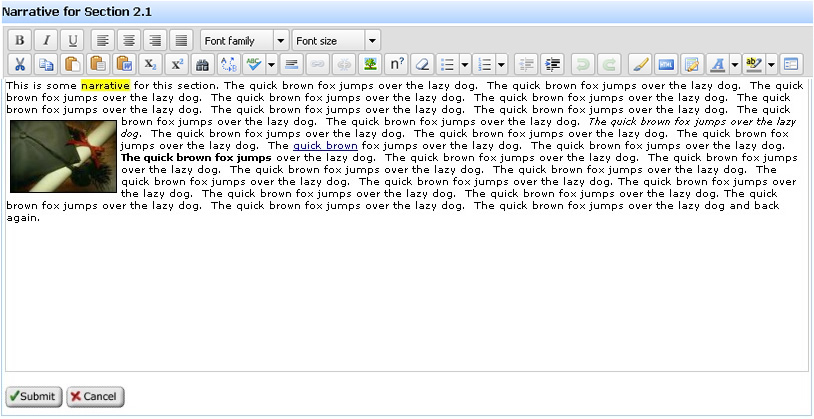|
<< Click to Display Table of Contents >> Using the Text Editor |
  
|
|
<< Click to Display Table of Contents >> Using the Text Editor |
  
|
The built-in WYSIWYG (What You See Is What You Get) text editor lets you enter narratives, preambles, reports and responses.
The editing functions are similar to those found in a typical word processing application. The default font style for the editor is Arial 11pt.
![]() While the editor provides considerable freedom in formatting text, most agencies prefer a simple and consistent text style.
While the editor provides considerable freedom in formatting text, most agencies prefer a simple and consistent text style.
Changing fonts and text sizes within the same or across multiple narratives may detract from the look of a published document or website and is not recommended.

![]() After you edit narrative, do not forget to click the Submit button.
After you edit narrative, do not forget to click the Submit button.
Hyperlinks may be added by highlighting text first and then clicking the ![]() link icon in the toolbar or by using the mouse right-click function. To remove a hyperlink use the
link icon in the toolbar or by using the mouse right-click function. To remove a hyperlink use the ![]() unlink icon. Links can be replaced automatically by end-note references in a published submission if the end-note function is available in the presentation template. See Control Panel > Presentation templates.
unlink icon. Links can be replaced automatically by end-note references in a published submission if the end-note function is available in the presentation template. See Control Panel > Presentation templates.
To insert an image click on the ![]() add image icon and select an image file from the drop-down. You can format the image further by clicking on the Appearance tab.
add image icon and select an image file from the drop-down. You can format the image further by clicking on the Appearance tab.
![]() A hyperlink reference or image file must already exist in the evidence list for the section in order to appear in the drop-down.
A hyperlink reference or image file must already exist in the evidence list for the section in order to appear in the drop-down.
Create a table by clicking on the ![]() add table icon. Right click on the table to make any format changes.
add table icon. Right click on the table to make any format changes.
Insert a break in the published PDF document by clicking the ![]() page break icon.
page break icon.
![]() To avoid possible right margin text overflow in a PDF document submission, avoid including tables or images that exceed 600px in width.
To avoid possible right margin text overflow in a PDF document submission, avoid including tables or images that exceed 600px in width.
For footnotes, use the ![]() superscript icon then create a list of footnotes at a suitable place in the narrative. (This is a manual function).
superscript icon then create a list of footnotes at a suitable place in the narrative. (This is a manual function).
You can check the number of words in the narrative by clicking on the ![]() icon.
icon.
To find and replace a word click on the ![]() icon.
icon.
To remove formatting previously applied, highlight on the word or words and click on the ![]() remove formatting icon.
remove formatting icon.
Click on the ![]() full-screen icon to toggle between full and normal view of the text editor.
full-screen icon to toggle between full and normal view of the text editor.
Some useful tips that will help minimize formatting issues when copying and pasting text from other documents:
•Text copied from another narrative should be pasted using the ![]() paste as plain text icon.
paste as plain text icon.
•Text copied from another document, e.g. a web page, should be pasted using the ![]() paste as plain text icon.
paste as plain text icon.
•Text copied from an MS Word® document should be pasted using the ![]() paste from Word icon.
paste from Word icon.
•Tables copied from another document should be pasted using the ![]() paste as plain text icon.
paste as plain text icon.
![]() Information copied and pasted from other sources may contain proprietary formatting characters or invalid links. This may cause problems later when publishing a submission.
Information copied and pasted from other sources may contain proprietary formatting characters or invalid links. This may cause problems later when publishing a submission.
Check the quality at any time by using the Preview function.
If an invalid link has been pasted, a warning message will be generated when you update the narrative. See also Link Check Report.
If your system is configured to allow direct editing of the narrative HTML, the ![]() HTML function will be present.
HTML function will be present.
Click on the icon to open an HTML editing window. This also provides access to the Word Redo function. Use this function to remove embedded formatting from a pasted Word document.
See also Narrative Cleanup tools.